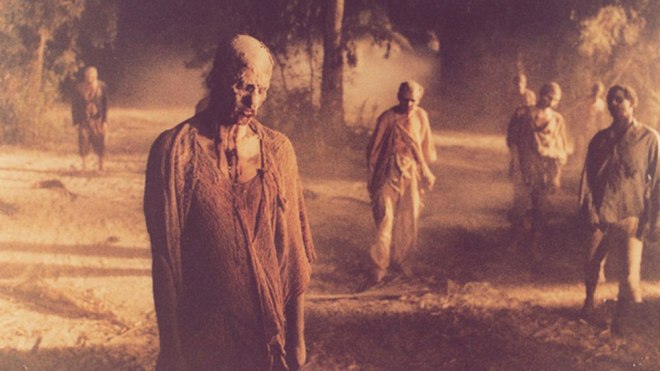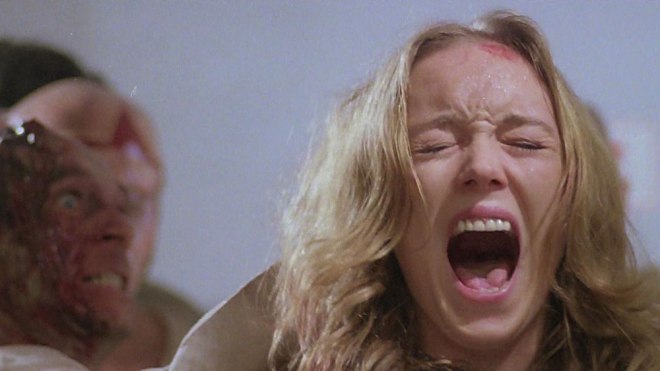Confession time: I’m not all that scared by horror movies. Of course, a loud jump scare will get me every time and I’ll flinch at a brutal slasher movie slaying but the terror rarely lasts any longer than the film itself. Even as a youngster I knew what I was seeing wasn’t real so I didn’t spend a lot of restless nights worrying if a monster or madman was coming to get me. My enjoyment of horror films comes more from the atmosphere, visuals and bizarre scenarios than being scared in the traditional sense. Still, there is one movie that deeply affected me when I first saw it and still sends a chill up my spine today, even if it’s not technically a movie at all.
Ghostwatch was a one-off TV show that aired on BBC One on Halloween night, 1992. Although it was part of the BBC drama anthology series Screen One, it was presented as a genuine live investigation into a haunting at a London council house. The story – heavily inspired by the allegedly real Enfield Poltergeist case – concerned a divorced mother and her two young daughters being menaced by a malevolent spirit dubbed ‘Pipes’, due to the eerie clanging noises it made on the house’s plumbing system. Into this accursed abode would go legitimate TV presenter Sarah Greene and comedian Craig Charles as investigators, while chat-show legend Michael Parkinson and Greene’s real-life husband Mike ‘Smithy’ Smith held things down back in the studio. What starts off as a jovial, light-hearted ghost hunt quickly gets out of hand, leading to a shocking conclusion that leaves you questioning everything you’ve just seen.
It was my mother, of course, who first alerted me to Ghostwatch a few days before it aired and at 9pm on October 31, there I was in front of the TV, ready for some real-life Halloween scares. And I genuinely did think it was real (at least to begin with), along with a sizeable chunk of the viewing public. It’s easy to mock now, with our gizmos and gadgets beaming ‘reality’ into our brains 24/7, but back in 1992 why would we NOT think it was real? The early ’90s brought the dawn of reality TV and along with the then-novel live telethons like Comic Relief and Children In Need, we were getting used to camera crews following around the emergency services for shows like Hospital Watch. Then there were the presenters. We all knew Sarah Greene and Craig Charles from kids’ TV and Red Dwarf, and who could be more trustworthy than the venerable Michael Parkinson? Most important of all, it was on the BBC. Auntie would NEVER lie to us, surely?!

Although it had been filmed months before transmission, for all intents and purposes Ghostwatch looked exactly like a live TV broadcast should, starring the exact people you would expect to see, and until things really started to go bonkers later on in the show there was absolutely no reason to believe what you were watching wasn’t real. Had I watched it straight through from beginning to end, perhaps the pretence would have fallen sooner, but such was my level of fear at what I was witnessing I spent most of the night switching back and forth between channels, utterly terrified but unable to stay away for long. This fragmented viewing only added to the ‘reality’ of the situation and by the time we got to the shocking finale, I went to bed with the strong possibility that I’d just seen a genuine haunting on live TV.
I wasn’t the only one. Come the morning, the entire country (or at least the tabloid press) was in uproar. No BBC programme had ever received so many complaints. As the moral outrage mounted and calls for heads to roll intensified the BBC scrambled for cover, but when it emerged a few days later that a young man with learning difficulties had taken his own life, possibly as a result of the programme, a moratorium was placed on Ghostwatch ever being shown again.
Although Pipes was gone, gathering cobwebs in the BBC vaults, he certainly wasn’t forgotten. Ghostwatch had earned a place in television infamy, alongside that elephant having a wee on Blue Peter and the drunken antics of Oliver Reed, and every now and then conversation would turn to memories of that Halloween night in 1992. Even years later as an adult, a creepy, witching hour creak from the plumbing system still had the ability to unsettle me for the rest of the night. Once I got online at the turn of the millennium I soon discovered I wasn’t the only one still having trouble sleeping. With a little bit of digging around you could find others sharing their recollections of Ghostwatch on various websites and message boards, and if you were really lucky you might find a screen grab or two from an old VHS tape or a scan of an outraged tabloid front page from the morning after. While these online finds were good, it wasn’t until 2002 when the BFI released it on DVD that I got to see Ghostwatch in its full glory once again.
Ten years and countless horror films had passed since I had last seen it but the feelings of unease as I put the disc into the player were very real. I knew by now it had all been make-believe of course, but the sinewy, spectral fingers of Pipes dug deep into the darkest recesses of my brain and churned up feelings of dread that I had last felt as a teenager. My biggest fear, though, was that in the bright light of adulthood, this terrifying memory would be exposed as a damp squib, more likely to elicit chuckles than fear – but against all odds I found it still held the power to unnerve. It was a relief to find that Ghostwatch was genuinely still scary.
What was most impressive was realising just how much effort had been put into making it appear as a genuine live broadcast. They say you should never ask how a magician does their tricks, but the commentary track featuring the culprits behind Ghostwatch – Stephen Volk, Ruth Baumgarten and Lesley Manning – in which they lay out in detail exactly how it was accomplished, is a revelation. From tiny touches like the slight delay when an expert appears in a trans-Atlantic link from ‘New York’ to casting real-life outside broadcast camera and sound men rather than actors, I say without hyperbole that I consider it a work of television genius and I feel no shame in being duped on Halloween night back in 1992.
For those of us who saw it at the time, Ghostwatch provides a shared generational memory that still elicits chills today. It’s sad to think that something like Ghostwatch could never happen now (someone might get offended!), but every year on Halloween I’ll dutifully watch it once again – at 9pm for the genuine experience if fate allows – to get a fear fix that so many traditional horror movies can’t ever hope to deliver.
























